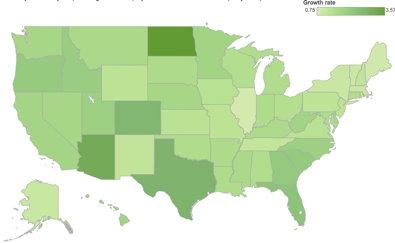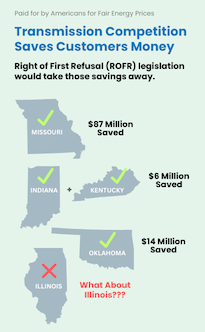|
Today’s numbers are bad, too
Friday, Jan 10, 2014 - Posted by Rich Miller * Moody’s Analytics ranks Illinois dead last among the 50 states for projected 2014 job growth. The firm is predicting a growth rate next year of just 0.98 percent. Click on the pic for the full interactive map…  Indiana is ranked 25th at 1.60 percent. Wisconsin is ranked 32nd at a projected 1.49 percent growth for the year. And Michigan is 27th at 1.55 percent 2014 projected growth.
|



















- RonOglesby - Friday, Jan 10, 14 @ 11:25 am:
there are tons of things that go into growth in those numbers. If you have a second this is an article on Cali, (SHORT) but think about how this same type of stuff applies here in Illinois…
http://www.bloomberg.com/news/2014-01-08/for-small-businesses-small-matters.html
Time to make changes to your business? rules around changes, law suits, etc, etc. Business friendly is just not some simple tax rate change or tax rebates to specific companies. We need small companies starting and growing here to change these numbers.
- Ahoy! - Friday, Jan 10, 14 @ 11:27 am:
Since the legislature listens to Moody’s when it comes to bonds, maybe they will listen to them when it comes to this as well and finally do something about our poor business climate?
- wordslinger - Friday, Jan 10, 14 @ 11:39 am:
Looks like we’re the shortest pygmy in the Midwest, which ain’t exactly gangbusters.
Except Minnesota at 12. What’s going on there?
- walker - Friday, Jan 10, 14 @ 11:40 am:
Cannot deny reality.
But as Ron says, let’s not settle for simplistic solutions (like taxes), and let’s focus on the real growth engines (like small companies).
- All Business - Friday, Jan 10, 14 @ 11:44 am:
Illinois already has all of the jobs. The other states need jobs, so they will do anything to get them. So I guess we should be greatful.
- Just Observing - Friday, Jan 10, 14 @ 11:49 am:
We can’t just look at state government for solutions… local governments must also be proactively reforming their regulations to make conducting business easier, more transparent, and predictable.
- Formerly Known As... - Friday, Jan 10, 14 @ 11:52 am:
This could be the nudge we need to reach dead last in unemployment rate among the states in 2014.
Illinois… #1 with a bullet.
- RNUG - Friday, Jan 10, 14 @ 11:53 am:
Given these numbers, maybe Rutherford is on to something with his desire to grow jobs. Now if the desire could be translated into effective policy …
- in absentia - Friday, Jan 10, 14 @ 11:56 am:
When government is constantly involving itself in business’ activities, the private sector freezes until order is maintained. Uncertainty is the biggest drag on the private sector. Keep the G.A. out of business, and it will thrive. Until then IL will maintain its low rank in job incubation.
- PublicServant - Friday, Jan 10, 14 @ 12:02 pm:
On the other hand, Illinois added more jobs than all but 11 states. See. Just depends on how you look at it.
- wordslinger - Friday, Jan 10, 14 @ 12:07 pm:
–When government is constantly involving itself in business’ activities, the private sector freezes until order is maintained. Uncertainty is the biggest drag on the private sector.–
Where do you get this stuff?
Has there been some great sea-change in GA interference since Dec. 2008, when the unemployment rate was 4.4%?
The idea that the General Assemply can serve as some sort of thermostat that can make adjustments in a global economy is just kooky.
http://ycharts.com/indicators/illinois_unemployment_rate
Businesses grow when they sell. If they’re not selling, they’re not growing. Consumers drive sales. If they’re not buying, you’re not growing.
Outside of the Chicago Metro, the Illinois economy is dominated by agriculture, which has been shedding jobs for decades.
What are the job-growth opportunities in an ag economy?
- PublicServant - Friday, Jan 10, 14 @ 12:07 pm:
Err, I mean projected to add…sorry. And Illinois is in the top quarter of states in number of new jobs projected to be created.
- Now What? - Friday, Jan 10, 14 @ 12:09 pm:
Job growth should also include a snapshot of salary/wage earnings, specifically since the fastest growing areas of national job growth are also low wage paying jobs (not careers). The fear of jobs returning, and a dicey argument to make, means that we’ve cheapened labor to compete. A 21st century labor movement needs to recognize this unfortunate trend. Don’t know if they know how to or can.
- Formerly Known As... - Friday, Jan 10, 14 @ 12:17 pm:
Obviously, there is only one sure-fire formula to jump-starting our job growth. Illinois must
- raise the minimum wage
- raise taxes… or at least extend the “temporary” tax increase about to expire
- help pick winners and losers in private enterprise by continuing our corporate welfare handouts
- do nothing to address our absurd corporate tax system, where many companies pay 0% while mom-and-pop pay through the nose
Magic 8 Ball sez: “Signs point to yes”. /s
This is shaping up to be a long year.
- Jim'e' - Friday, Jan 10, 14 @ 12:28 pm:
I agree with PublicServant; its not the percentage, but number of jobs, and type of jobs. My guess is that WI and IN, which will create less jobs, are also creating jobs of lesser salary and skills.
- Willie Stark - Friday, Jan 10, 14 @ 12:36 pm:
And, of course, these are only projections. Put a note on the calendar to check back come Jan 2015 so we can revisit this post and see how predictive Moody’s really was. As a reason for optimism, in December, Fred Giertz’s flash index reached its highest level since April 2007 (http://igpa.uillinois.edu//flash-index/2013/december). Important to remember, so many variables and factors influence economic outcomes that any forecasts, whether for the stock market, bond prices, GDP, etc. have to be taken with a grain of salt. No one knows the future.
- Grandson of Man - Friday, Jan 10, 14 @ 12:46 pm:
The December jobs numbers were bad today. I’m hoping it’s an aberration, in the context of other recent positive data. Illinois has had recent positive jobs numbers.
I think we laid a good foundation in 2013 for our state’s future. We seriously began pension reform and passed MMJ and SSM. Indiana, the darling of some, is trying to pass a constitutional amendment to ban gay marriage. Do you want to live in a state that passes this type of legislation?
We should start by raising the minimum wage, I believe, and then consider legalizing marijuana.
- RonOglesby - Friday, Jan 10, 14 @ 12:52 pm:
Looking at raw numbers only to find something good to say will lead us no where. If you ahve two states, one with 10M people and one with 6M and the 12MIL edges out the 6 Mil by a few thousand jobs you are in trouble. Your growth in jobs needs to keep up with population…
These numbers in the article do not take into account the hole that Illinois is in in existing unemployment or % not in the workforce.
Being last in the list in projected growth and seeming to have the worst unemp rate (http://www.ncsl.org/research/labor-and-employment/state-unemployment-update.aspx) of our surrounding states we need to start looking for fixes to our mind set, not some way to spin the numbers. Spinning numbers is how we got here.
- Judgment Day - Friday, Jan 10, 14 @ 12:53 pm:
You want to create more job growth?
FOCUS on issues like that $70 mil advanced manufacturing grant from DARPA that’s being fought over between the U of IL - Urbana/Champaign and Huntsville, Alabama.
We ought to tell our Congressional delegation (both sides) to either get it done and get the grant, or don’t come back home (Re: Sparta; ancient Greece - “With your shield or on it”). You wanted the job, ran for it, got it - so bring the grant back home!
This DARPA grant is the type of project that kickstarts greater things.
- Formerly Known As... - Friday, Jan 10, 14 @ 1:17 pm:
Percentages, ratios and per-capita measures are important in circumstances like this as a gauge of underlying health and wealth.
The reasons for this are simple: large population states might create more jobs in sheer # than smaller population states, but they have to in order to survive and thrive.
Emphasizing raw #’s in cases like this, rather than emphasizing ratios, can be sorely misleading.
Illinois better create more jobs than, say, Rhode Island. Because we have to in order to support our higher expenses, broader public services, larger numbers of elderly and disabled populations, and so on.
- Demoralized - Friday, Jan 10, 14 @ 1:31 pm:
If we would only lower the minimum wage . . .
- Formerly Known As... - Friday, Jan 10, 14 @ 2:14 pm:
=== Except Minnesota at 12. What’s going on there? ===
I wondered the same thing. Then I saw:
=== If we would only lower the minimum wage ===
It turns out Minnesota is the only one of those states with a minimum wage rate lower than the federal.
Not saying that is the only possible explanation but, sadly, it may be one.
- Name Withheld - Friday, Jan 10, 14 @ 2:22 pm:
Has Moody’s been talking to Ty Fahner again?
- wordslinger - Friday, Jan 10, 14 @ 2:26 pm:
FKA the vast majority of workers in Minnesota are covered by the federal rate.
Louisiana, Arkansas and Mississippi have no minimum wage laws. Not exactly industrial powerhouses.
- Formerly Known As... - Friday, Jan 10, 14 @ 3:51 pm:
Thanks, Word. I used the Dept of Labor’s chart as a source. All it indicates is Minnesota as 1 of only 4 states below than the Federal level (one of only 4 states in red). It doesn’t really note or indicate the important point you mention (which I assume is accurate). So odd they wouldn’t clarify that.
www.dol.gov/whd/minwage/america.htm